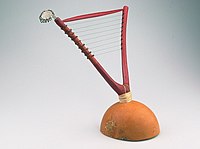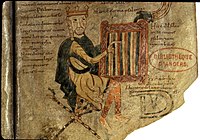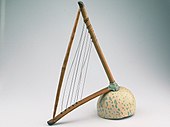|
Frame zither
Stylized drawing in a medieval manuscript shows a man playing an instrument with strings stretched across a frame. Text reveals it is a psaltery, which means it would have a board behind the strings and not be a frame zither. Frame zither is a class of musical instrument (subset of zither) within the Hornbostel-Sachs classification system for a type of simple chordophone (stringed instrument), in which the body of the instrument is made from a frame.[1] Frame zithers are musical instruments in which strings are strung across an open frame.[2] They could be similar to harps and psalteries which can also have strings stretched across frames. However, in harps the strings run from the frame to a resonating table embedded into the frame on the frame's other end. Psalteries may also have a frame, but behind the strings (parallel to them) is a board, the top of a box which acts as a resonator. Musicians may add a resonator as is done with a bow harp; they can attach or put the instrument into a calabash gourd or a ceramic pot.[3] Under the Hornbostel-Sachs system of musical instrument classification, any frame with strings stretched across, and without a built in resonator, would count as a frame zither. In musical instrument encyclopedias, however, there are few or no examples of frame zithers except those found in Africa. Potential examples include medieval European illustrations; these however are not clear and could equally illustrate forms of harps or psalteries.[1] AfricaTriangularAfrican frame zithers are made with frames of three "arms" forming a triangle, or a round frame made of wood.[3] Two of the arms are inserted into a calabash gourd base, with the base of the gourd cut away.[4] The gourd acts as a resonator.[4] The instrument is played by holding the opening in the resonator against the player's chest or stomach, with the instrument being within reach of their arms.[4][5][6] The main known example are instruments of the Kru people of Liberia. They may also be seen in Sierra Leone and Guinea.[4] RoundAnother form of African frame zither uses a round frame or hoop, with the strings stretched across it.[3] Women of the Nuba people of Sudan make round frame-zithers, by bending a stick into a hoop, spanned 3 or four times by a single string (forming individual lengths to play).[3] The instrument is placed on top of a gourd for resonance.[3] Recordings
References
|
||||||||||||



